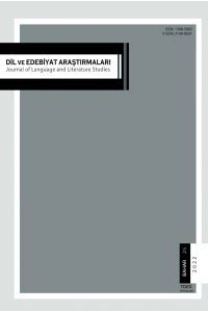Cahit Külebi’nin “Zerdali Ağacı” Şiiri Odağında Şiirde Bağıntı, Derin Yapı Ve Matris
Şiirin nasıl anlamlandırılacağı meselesi, şiir eleştirisinin önemli sorunsallarından biridir. Metinlerin genellikle semantik açıdan değerlendirilmesi, göstergebilimsel eleştiriye dek değerli görülmüş, öncülüğünü sürdürmüştür. Göstergebilim ve ona bağlı başka kuramlar, metin çözümleme etüdüne ciddi katlı sağlar. Bu paralelde bağıntı, derin yapı-yüzey yapı ve matris gibi kavramlar modern şiir incelemelerinde önemli anahtarlardır. Cahit Külebi’nin “Zerdali Ağacı” şiiri bu üç anahtarla okunabilecek zengin katmanlı bir metindir. Bu makalede Sperber ve Wilson’ın “bağıntı”, Riffaterre’in “matris”, Chomsky’nin “derin yapı-yüzey yapı” kavramları eşliğinde şiirin semantik çözümlemesi yapılmıştır. Bağıntı sorgulaması yoluyla şair ve okur arasındaki estetik iletişim, matris aracılığıyla şiirin gizli sembolü, “derin yapı-yüzey yapı” kavramları ışığında da metnin göndergeleri ortaya koyulmuştur. “Zerdali Ağacı” şiiri, doğadan alınan somut verilerin sembolist semantik değere taşınmasının en derinlikli örneklerinden biridir. Doğayı ve insanı yakından tanıyan Cahit Külebi bu şiirde ağaç ile kadın arasında kurduğu bağlantıyı yaşamın ve zamanın akışı içinde eş zamanlı bir kronolojiye bağlamıştır. İnsana özgü özelliklerin ağaca yüklenmesi ve sorgulamanın, uyarıların bu bakış açısından yapılması şiirdeki anlam derinliğinin artmasına katkı sağlamıştır.
The Poem of Cahit Külebi’s “Zerdali Tree” is in Focus Connection, Deep Structure and Matrix in Poetry
The issue of how to make sense of poetry is one of the important problematics of poetry criticism. Evaluation of texts generally in terms of semantics was considered valuable until semiotic criticism and continued its pioneering. Semiotics and other theories attached to it provide a serious contribution to the study of text analysis. In this parallel, concepts such as relation, deep structure and surface structure, matrix are important keys in modern poetry studies. Cahit Külebi’s poem “Zerdali Ağacı” is a richly layered text that can be read with these three keys. In this article, the semantic analysis of this poem has been made, accompanied by the concepts of “relation” by Sperber and Wilson, “matrix” by Riffaterre, and “deep structure-surface structure” by Chomsky. Has been revealed aesthetic communication between the poet and the reader through the question of correlation, the hidden symbol of the poem through the matrix, and the referents of the text in the light of the concepts of deep structure-surface structure. The poem “Zerdali Tree” is one of the most profound examples of the transfer of concrete data from nature to a symbolist semantic value. Cahit Külebi, who knows nature and people closely, connected the connection he established between the tree and the woman in this poem to a simultaneous chronology in the flow of life and time. Attribution of human characteristics to the tree and questioning and warnings from this point of view contributed to the increas e of the depth of meaning in the poem.
___
- Ahmet Haşim, Bütün Şiirleri (haz. İnci Enginün-Zeynep Kerman), Dergâh Yay., İstanbul 1987
- İlhan, Attilâ, Sisler Bulvarı, Bilgi Yay., Ankara 1997
- Berk, İlhan, Toplu Şiirler I: Eşik: 1947-1975, Yapı Kredi Yay., İstanbul 1999
- Burton, S. H., The Criticism of Poetry, Longman House, Essex 1985
- Cansever, Edip, Bütün Şiirleri II: Sonrası Kalır, Yapı Kredi Yay., İstanbul 2018
- Cemal Süreya, “Ülke”, Sevda Sözleri, Yapı Kredi Yay., İstanbul 1990
- Dünya Şiiri (haz. Hüseyin Akakan), Yeni Matbaa, İstanbul 1957
- İkinci Yeni Şiir (haz. Mehmet H. Doğan), İkaros Yay., İstanbul 2008
- Külebi, Cahit, Bütün Şiirleri, Adam Yay., İstanbul 1990
- Anday, Melih Cevdet, Toplu Şiirler II: Ölümsüzlük Ardında Gılgamış, Adam Yay., İstanbul 2002
- Perrine, Laurence, The Elements of Poetry, Southern Methodist University, Texas 2010
- Riffaterre, Michael, Semiotics of Poetry, Indiana University Press, London 1978
- Eagleton, Terry, Şiir Nasıl Okunur, Agora Kitaplığı, İstanbul 2011 (çev. Kaya Genç)
